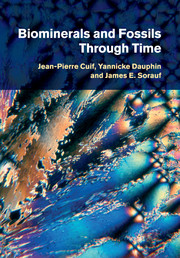Book contents
- Frontmatter
- Contents
- Preface
- Introduction: Milestones in the study of biominerals
- 1 The concept of microstructural sequence exemplified by mollusc shells and coral skeletons
- 2 Compositional data on mollusc shells and coral skeletons
- 3 Origin of microstructural diversity
- 4 Diversity of structural patterns and growth modes in skeletal Ca-carbonate of some plants and animals
- 5 Connecting the Layered Growth and Crystallization model to chemical and physiological approaches
- 6 Microcrystalline and amorphous biominerals in bones, teeth, and siliceous structures
- 7 Collecting better data from the fossil record through the critical analysis of fossilized biominerals
- 8 Results and perspectives
- List of references
- Name index
- Subject index
6 - Microcrystalline and amorphous biominerals in bones, teeth, and siliceous structures
Data illustrating the nature of calcareous biocrystals
Published online by Cambridge University Press: 10 January 2011
- Frontmatter
- Contents
- Preface
- Introduction: Milestones in the study of biominerals
- 1 The concept of microstructural sequence exemplified by mollusc shells and coral skeletons
- 2 Compositional data on mollusc shells and coral skeletons
- 3 Origin of microstructural diversity
- 4 Diversity of structural patterns and growth modes in skeletal Ca-carbonate of some plants and animals
- 5 Connecting the Layered Growth and Crystallization model to chemical and physiological approaches
- 6 Microcrystalline and amorphous biominerals in bones, teeth, and siliceous structures
- 7 Collecting better data from the fossil record through the critical analysis of fossilized biominerals
- 8 Results and perspectives
- List of references
- Name index
- Subject index
Summary
In contrast to the process of calcareous biocrystallization, for which different interpretations are still being debated in current literature, questions concerning the state of the mineral phase in bones and teeth on the one hand, and in siliceous structures on the other, are not particularly a matter of controversy at comparable scales. As in calcareous structures, the observation of thin sections in polarized light with the optical microscope has permitted establishing the crystal organization of phosphatic material in bones and teeth, as well as the amorphous state of the silica in sponge spicules (as well as in diatoms, unicellular algae, and the Radiolaria). Surprisingly, questions that do arise concerning the more precise characterization of these two very different mineral phases have comparable causes. In bones and teeth, crystals are so small that, until electron microscopy, and now atomic force microscopy, direct observation was impossible. Yet bone and tooth constituents are by far the most studied of all mineralized biological structures, essentially in medical or dental research. The situation is still more frustrating concerning the mechanisms leading to the striking paradox in all siliceous biomineralized objects. In every case, morphology is seen clearly to be controlled, right up to the highest resolution of instrumentation, although this was first demonstrated in the spectacular drawings of microscopic observations of radiolarians made by Haeckel in the nineteenth century, and since completely confirmed by scanning electron microscopy.
- Type
- Chapter
- Information
- Biominerals and Fossils Through Time , pp. 315 - 348Publisher: Cambridge University PressPrint publication year: 2010

